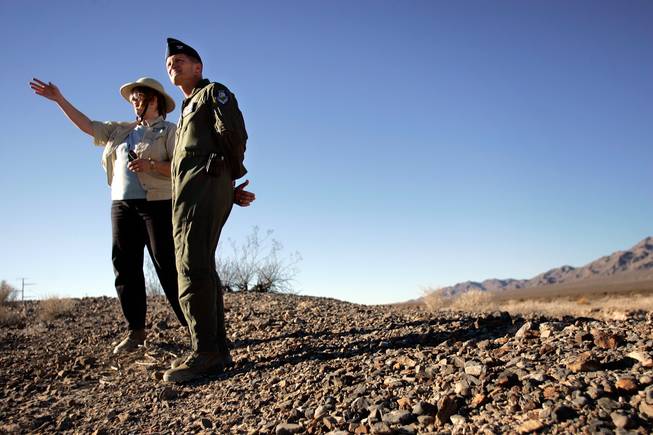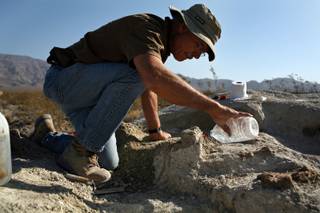
Jill DeStefano, founder of the Protectors of Tule Springs, tours the Upper Las Vegas Wash with Col. Dave Belote in 2008. The group wants to preserve the fossil beds in the northwest valley that may be designated a national monument. But NV Energy has its own plans for the site.
Published Wednesday, June 27, 2012 | 11:41 a.m.
Updated Wednesday, June 27, 2012 | 12:50 p.m.
Sun Archives
- Legislation preserving fossil-rich area north of Las Vegas as national monument expected this year (3-20-2012)
- Tule Springs tours offer vistas into the past (5-11-2005)
- Valley residents get chance to protect Las Vegas Wash (4-29-3005)
- Researchers hoping to protect fossil sites (12-8-2004)
- More ancient treasures found (10-1-2003)
- Revisiting Tule Springs' 'Big Dig' (11-1-2002)
Beyond the Sun
After years of work, federal legislation was introduced today to fashion a national monument out of 23,000 acres of ice age fossil-rich land in the north end of the valley.
U.S. Sen. Harry Reid, D-Nev., introduced the Las Vegas Valley Public Lands and Tule Springs Fossil Beds Monument Act, which would designate about 22,650 acres as the Tule Springs Fossil Beds National Monument. The legislation, which is cosponsored by Sen. Dean Heller, R-Nev., also would expand the Red Rock Canyon National Conservation Area, set aside lands for the expansion of Nevada institutions of higher education and make thousands of acres available for private development and job creation in the Las Vegas Valley.
Congresswoman Shelley Berkley, D-Nev., is introducing a companion bill in the House of Representatives.
Lynn Davis, program manager of the Las Vegas field office of the National Parks Conservation Association, said the legislation, if approved, would be a "big, big deal for Nevada."
"To have another national park in the state, that's huge," she said. "Look at all the national parks in Arizona and Utah and the economic potential that something like this brings. It would be accessible to residents and to 40 million visitors a year."
For many years, people adjoining the fossil area and others have fought — through meetings, letters and petitions — for preservation. The east end of the acreage lies just north of the Aliante master-planned community, where a public park pays homage to paleontology with fake dinosaur fossils in a play area. Its west end stops at U.S. 95, then edges northwest to about Corn Creek.
The movement to preserve the area was bolstered somewhat by the recession. At one time, Las Vegas hoped to build an east-west highway between U.S. 95 and I-15 to the east, which would have brought homes and malls with it. The economy dried up and so did development ideas for that area. Now the city is on record supporting the national monument, as is Clark County, North Las Vegas, Nellis Air Force Base and the Las Vegas Paiute tribe. Dozens of citizen and environmental groups nationwide also have expressed support.
"Awesome," said Las Vegas Councilman Steve Ross, when told of the news. His ward abuts the land.
"It's no secret that we have some rich paleontological finds in our northwest valley, and this is a great opportunity for the city. People from around the world love to come here for Valley of Fire and Red Rock. This is just a great addition to that."
Over decades, some 10,000 fossils had been excavated from the area — some without digging, as they would be located simply lying atop the soil — and are preserved in the San Bernardino (Calif.) County Museum. Ross made note of that.
"I envision one day a prehistoric museum out there, and I want that stuff back and put in that museum," he said, chuckling. "That's Las Vegas history, not California history."
In a news release issued this afternoon, Reid said the legislation also would make more land available for the expansion of campuses within the Nevada System of Higher Education, create job opportunities in southern Nevada, broaden the Red Rock National Conservation Area and hels improve management of the Spring Mountain National Recreation Area.
It also would convey land to Clark County for an off-highway vehicle recreation park, and designates public lands surrounding the park as an off-highway vehicle recreation area to help keep riders off of sensitive lands and habitat. Finally, the bill designates a corridor, under the jurisdiction of the Bureau of Land Management, for a transmission line that will be primarily used to carry renewable energy.
Jill DeStefano, leader of the group Protectors of Tule Springs, has worked six years to reach this day.
"We are extremely excited," she said. "And we all plan to continue working together to see this through to the end and not let it disappear into the bowels of Congress."
DeStefano also noted with a bit of disappointment that Nevada Energy has extremely large power transmission lines running through the area. To date, no plans or agreements have been made to move them.
Davis also mentioned the power lines and still hopes there will be some way to move them.
"All we want is for this to be the best possible national park unit, and those transmission lines are still a concern to us," she said.
For now, however, the focus is on celebrating the simple fact that for the first time, federal legislation is moving to preserve an area that for decades has been known for its rich cache of fossils.


Join the Discussion:
Check this out for a full explanation of our conversion to the LiveFyre commenting system and instructions on how to sign up for an account.
Full comments policy